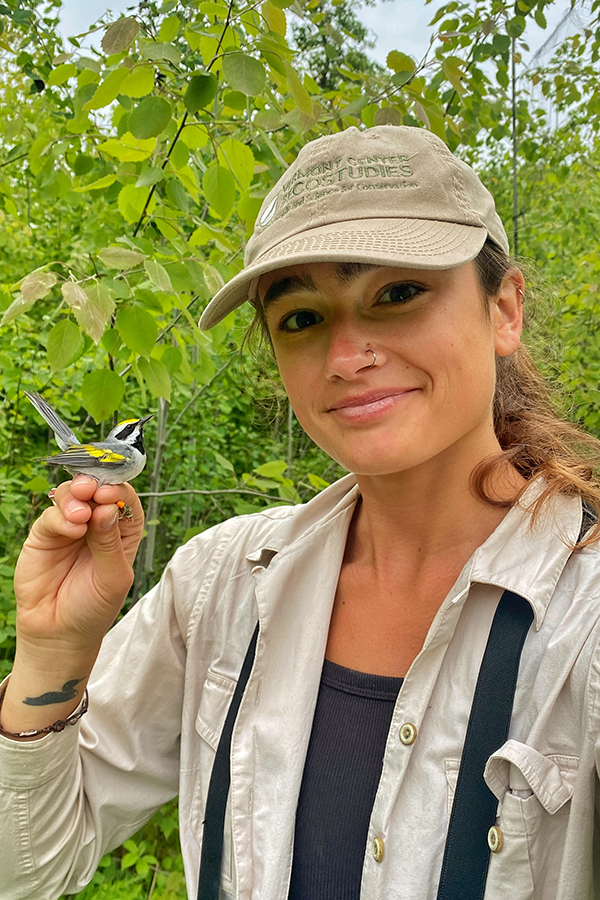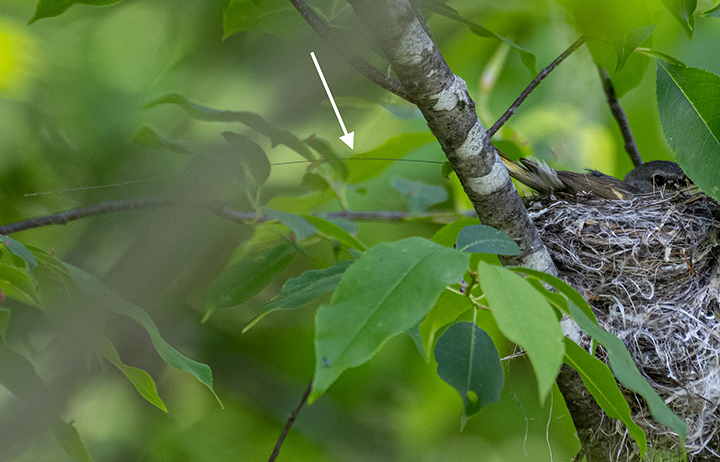Science afield: Emily Filiberti makes an extraordinary bird connection
Written by Emily Filiberti, Master’s of Science student in wildlife ecology

The return of songbirds en masse to northern forests marks the arrival of spring. However, we rarely know the exact location where these birds have spent their winter, or the routes that they navigated during migration. As a graduate student at the University of Maine, my small team of researchers made the long trek from the Northeast to the Midwest to study a rapidly declining songbird called the golden-winged warbler. I hoped to find returning warblers sporting NanoTags, a type of radio transmitter tag, that I deployed on individuals in the spring of 2021. My project relies on Motus Wildlife Tracking System (Motus) stations, a collaborative network of automated radio-tracking receivers, to assess annual survival rates of both male and female golden-winged warblers rangewide. As part of this research, we constructed two Motus stations near our field sites in order to detect our golden-winged warblers, as well as any additional species tagged by other researchers.
One of our Motus stations, located within the U.S. Forest Service’s Rhinelander Experimental Forest, picked up several spring migratory detections, including a Virginia rail marked in Illinois, a blackpoll warbler marked in Colombia, and one of our returning male golden-winged warblers. In addition to these detections, an American redstart, marked just two months prior on its wintering grounds in Jamaica, was detected on May 28. With our Motus stations garnering little activity during fall migration in 2021, we were ecstatic to have picked up these birds, and humbled that our station had contributed to understanding the migratory pathways of these species.
On the morning of June 6, with rain streaming outside the window of our field housing, I made the call to delay our normal field activities. With rare and precious downtime now available, I decided to peruse the Motus interface again in hopes that our stations picked up more migratory detections. It was then that I noticed that the same American redstart was picked up again on June 4, eight days after it was initially detected. This no longer seemed like a detection during migration – this American redstart was sticking around the area.
Intrigued, I looked up the project contact and noticed that it was Dr. Bryant Dossman, my old crew leader when I interned on Dr. Peter Marra’s (Georgetown University) long-term winter ecology project at the Font Hill Nature Preserve in southwest Jamaica. Since my departure as an intern, he was continuing to work with the same population of American redstarts as part of his postdoctoral work. I messaged him immediately and mentioned that I was fairly certain one of his redstarts had chosen to breed in the area. Bryant confirmed that this was a female tagged on April 5 at Logwood 1, a site that I was all too familiar with. Elated about the possibility of knowing this individual’s exact wintering and breeding location, we decided that I would go out on foot to see if I could locate this bird using my hand-held tracking receiver.
My field technician, Lucas Campbell, and I drove immediately to where our Motus tower was stationed. Once we arrived, Lucas hooked up our hand-held antenna to our receiver and he positioned it outside of the car window. I slowly drove down the dirt road until Lucas picked up a faint beep – a signal confirming a detection of a bird – that we were confident was not from one of our golden-winged warblers. After I looked up the tag’s ID and confirmed it was in fact one of the American redstarts tagged by Bryant, we both looked at each other and grinned – we found her! With the rain calming to a fine mist, we exited the car and started to orient the antenna towards the strongest signal. It pointed us directly to a small swatch of forest that was privately owned, tucked away between agricultural fields and residential homes. I quickly looked up the plat information for this property in the Oneida County land records system and obtained the name of the landowner.
Once I began reaching out to my small community in Oneida County, I discovered that the landowners were well known in the ecological community, including being prior co-workers with my advisor, Dr. Amber Roth. I quickly found their contact information and called them to explain our exciting situation. They were thrilled to allow us access to their property. The next day, Lucas and I once again set out to find this infamous American redstart. After spending 30 minutes following the signal strength outputted on our receiver, we finally found her, sitting squarely on her nest woven inside the fork of a young black cherry tree. Her long, glistening tag antenna was resting outside of the nest, extending off the tip of her tail. Completely awestruck, we watched this marvel of a bird for close to an hour. Once she finally left her nest to get a snack, I walked up to the nest and studied its contents – two small, brown-speckled glistening eggs.

In addition to knowing where this female spent the majority of the year on her wintering grounds, we now had definitive coordinates for where this female decided to breed. After departing Jamaica on May 9, she traveled more than 2,000 miles in less than 20 days. Prior to the fruition of the Motus Wildlife Tracking System, knowing these two coordinates for a single individual was close to impossible, particularly for those that have an extensive range. Had our small Motus station not picked up this American redstart on two different days, we would never have known to go out and seek this small bird. It truly brings into perspective how fortunate we are to have access to the technology that we do today, and opens up a small glimpse of what’s to come as we continue to expand the Motus network of automated receiver stations.
While the number of coincidences makes this story remarkably hard to grasp, what makes it even more difficult to comprehend is my personal connection to this small bird. Of all the Motus stations this American redstart could have nested in close proximity to, she selected a location that was right next to a station I run – someone who once traveled the same paths that she flew over, touched the same trees that she perched on, and overwintered at the Font Hill Nature Preserve. I feel a sense of kinship with this redstart, as in some small way, I also migrated from my temporary home in Jamaica, traveling long, perilous distances until I finally reached Rhinelander, Wisconsin, where I was dutifully tasked with elevated responsibilities and a small chance to create something huge. This bird is a subtle reminder of how connected we are as a community, both with one another and with the organisms that surround us. As I jokingly pointed out to Bryant, I didn’t find this bird, she found me.
The Motus Wildlife Tracking System relies on a network of individuals, researchers, companies, agencies, nonprofits, and academic institutions to host its stations. Those interested in establishing a Motus antennae to contribute to wildlife research in their area should visit motus.org.
